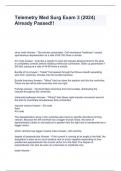Intranodal pathways Study guides, Class notes & Summaries
Looking for the best study guides, study notes and summaries about Intranodal pathways? On this page you'll find 11 study documents about Intranodal pathways.
All 11 results
Sort by
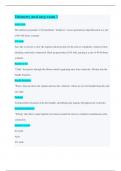
-
Telemetry med surg exam 3
- Exam (elaborations) • 23 pages • 2024
-
Available in package deal
-
- $12.99
- + learn more
Telemetry med surg exam 3 Sinus node The intrinsic pacemaker. Cell membrane "leakiness" causes spontaneous depolarization at a rate of 60-100 times a minute. AV node Acts like a resistor to slow the impulse allowing time for the atria to completely contract before initiating ventricular contraction. Back up pacemaker if SA fails, pacing at a rate of 40-60 times a minute. Bundle of his "Cable" that passes through the fibrous sheath separating atria from ventricles. Divides into th...
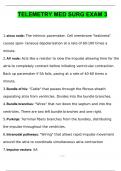
-
Medical Surgical Telemetry Exam 3 Questions with 100% Correct Answers | Verified | Latest Update 2024
- Exam (elaborations) • 29 pages • 2024
-
- $12.99
- + learn more
1. sinus node: The intrinsic pacemaker. Cell membrane "leakiness" causes spon- taneous depolarization at a rate of 60-100 times a minute. 2. AV node: Acts like a resistor to slow the impulse allowing time for the atria to completely contract before initiating ventricular contraction. Back up pacemaker if SA fails, pacing at a rate of 40-60 times a minute. 3. Bundle of his: "Cable" that passes through the fibrous sheath separating atria from ventricles. Divides into the bundle branches. 4....
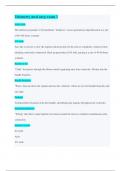
-
Telemetry med surg exam 3
- Exam (elaborations) • 23 pages • 2024
-
- $12.49
- + learn more
Telemetry med surg exam 3 Sinus node The intrinsic pacemaker. Cell membrane "leakiness" causes spontaneous depolarization at a rate of 60-100 times a minute. AV node Acts like a resistor to slow the impulse allowing time for the atria to completely contract before initiating ventricular contraction. Back up pacemaker if SA fails, pacing at a rate of 40-60 times a minute. Bundle of his "Cable" that passes through the fibrous sheath separating atria from ventricles. Divides into th...
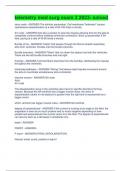
-
telemetry med surg exam 3 2023- solved
- Exam (elaborations) • 11 pages • 2023
-
- $11.49
- + learn more
sinus node - ANSWER-The intrinsic pacemaker. Cell membrane "leakiness" causes spontaneous depolarization at a rate of 60-100 times a minute. AV node - ANSWER-Acts like a resistor to slow the impulse allowing time for the atria to completely contract before initiating ventricular contraction. Back up pacemaker if SA fails, pacing at a rate of 40-60 times a minute. Bundle of his - ANSWER-"Cable" that passes through the fibrous sheath separating atria from ventricles. Divides into the bun...
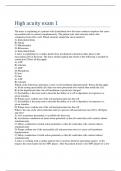
-
2024 LATEST High acuity NURSING exam 1
- Exam (elaborations) • 27 pages • 2024
-
- $11.99
- + learn more
The nurse is explaining to a patient with dysrhythmia how the heart conducts impulses that cause myocardial cells to contract simultaneously. The patient asks what structure allows this conduction from cell to cell. Which structure should the nurse mention? A) Intercalated disks B) Nuclei C) Mitochondria D) Ribosomes A) Intercalated disks A nurse is explaining to a cardiac patient how mechanical contraction takes place in the myocardial cells in the heart. The nurse should explain that ...
Telemetry Med Surg Exam 3 (2024) Already Passed!!
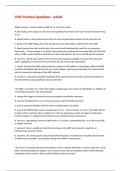
-
CMC Practice Questions - AACN - with verified answers
- Exam (elaborations) • 38 pages • 2023
-
- $7.99
- + learn more
CMC Practice Questions - AACN While caring for a patient with an IABP at 3:1, the nurse notes: A. decreasing urine output as well as increasing BUN and CR levels; the nurse should increase timing to 2:1 B. absent pulses in the proximal extremity; the nurse should apply pressure at the insertion site. C. blood in the IABP tubing; the nurse should disconnect the balloon catheter from the IABP. D. blood oozing from the insertion site; the nurse should anticipate the need for an emergency fas...
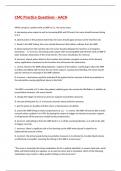
-
CMC Practice Questions - AACN - with correct and verified answers.
- Exam (elaborations) • 37 pages • 2023
-
- $7.99
- + learn more
CMC Practice Questions - AACN While caring for a patient with an IABP at 3:1, the nurse notes: A. decreasing urine output as well as increasing BUN and CR levels; the nurse should increase timing to 2:1 B. absent pulses in the proximal extremity; the nurse should apply pressure at the insertion site. C. blood in the IABP tubing; the nurse should disconnect the balloon catheter from the IABP. D. blood oozing from the insertion site; the nurse should anticipate the need for an emergency fas...
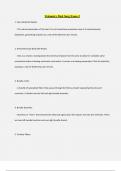
-
Telemetry Med Surg Exam 3
- Exam (elaborations) • 25 pages • 2024
-
- $10.43
- + learn more
Telemetry Med Surg Exam 3 1. Sinus Node (SA Node): - The natural pacemaker of the heart. Its cell membrane properties cause it to spontaneously depolarize, generating impulses at a rate of 60-100 times per minute. 2. Atrioventricular Node (AV Node): - Acts as a resistor, slowing down the electrical impulse from the atria to allow for complete atrial contraction before initiating ventricular contraction. It serves as a backup pacemaker if the SA node fails, pacing at a rate of 40-60 tim...
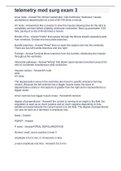
-
telemetry med surg exam 3 2022 with complete solutions.
- Exam (elaborations) • 11 pages • 2022
-
- $12.99
- + learn more
sinus node The intrinsic pacemaker. Cell membrane "leakiness" causes spontaneous depolarization at a rate of 60-100 times a minute. AV node Acts like a resistor to slow the impulse allowing time for the atria to completely contract before initiating ventricular contraction. Back up pacemaker if SA fails, pacing at a rate of 40-60 times a minute. 00:06 01:21 Bundle of his "Cable" that passes through the fibrous sheath separating atria from ventricles. Divides into the b...

Do you wonder why so many students wear nice clothes, have money to spare and enjoy tons of free time? Well, they sell on Stuvia! Imagine your study notes being downloaded a dozen times for $15 each. Every. Single. Day. Discover all about earning on Stuvia



